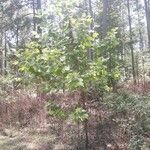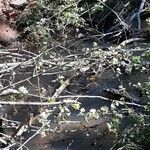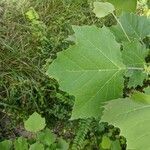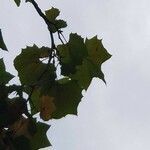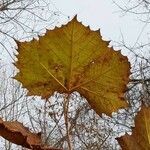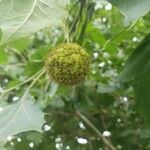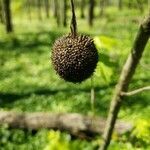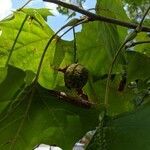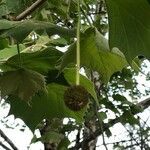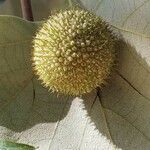Trees , to 50+ m, becoming massive; trunks straight and unbranched to great heights or low-branching or multitrunked, to 4+ m diam. Leaves: stipules entire to coarsely serrate. Leaf blade light green, usually shallowly 3-5(-7)-lobed, occasionally unlobed, 6-20+ × 6-25+ cm (to 30 × 40 cm on sucker shoots), not especially thick; lobes of blade mostly wider than long, basal lobes usually smaller, often strongly reflexed, sinuses broad and gently concave, depth of distal sinuses mostly less than 1/2 distance from sinus to base of blade, terminal leaf lobe 1/2-2/3 length of blade; margins entire to coarsely serrate, teeth sometimes short-awned, apex usually acuminate; surfaces glabrate, abaxially often persistently tomentose along veins. Pistillate inflorescences: heads 1(-2); fruiting heads 25-30 mm diam.; peduncle to 15 cm. Achenes 7-10 mm, basal hairs nearly as long. 2 n = 42.
Tree to 50 m, the trunk to 3 m thick, with pale greenish-gray to nearly white, exfoliating bark; lvs mostly reniform in outline, broadly 3–5 lobed, sharply serrate; stipules foliaceous, toothed or lobed; heads solitary, long-peduncled, 2.5–3 cm thick in fr; achenes 7–8 mm, nearly equaled by the subtending hairs; 2n=42. Moist or wet, alluvial soil; sw. Me. to s. Mich. and se. Minn., s. to Fla. and Tex.P. ×hybrida Brot., the London plane, a fertile putative hybrid of P. occidentalis and P. orientalis L., is widely planted as a street-tree and occasionally escapes. It typically has 2 heads per infl, and the lvs are often more truncate or broadly cuneate at the base; 2n=42. (P. ×acerifolia)
A deciduous tree. It grows 50 m tall and spreads 6 m wide. The stem is erect and branching. The bark is grey and flaking. The leaves are light green and have lobes arranged like fingers on a hand. The flowers are in round heads.
